What Guidebook Style Suits You?
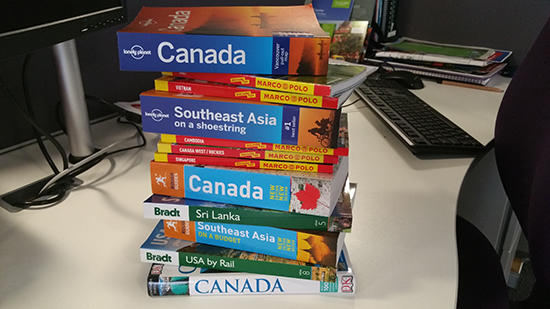
With an abundance of well-stocked bookstores on the high street, not to mention the rise of online literary retailers like Amazon, choosing the right guidebook to accompany you on the road can be a tad overwhelming. A lot of it comes down to your travel preferences though – are you planning to explore on a budget, for example? Are you going overland, cruising or by air? Is it a city break you’re planning, a two week flop and drop, or a round-the-world trip? And do you want to see the most iconic landmarks or feel like a pioneer while charting the less-trodden ones?
I asked five of the biggest guidebook brands – Rough Guides, Lonely Planet, Bradt, DK and Marco Polo – to send us some samples from the same country. They kindly obliged, furnishing me with five shiny Canada/USA guides, each of which has since been tried, tested and well-thumbed so we can help you decide which style suits you.
DK Eyewitness Travel
I love DK guides. They’re glossy, colourful – great for those who need some visual stimulation to really get the inspiration flowing. They offer a huge range, from top 10 guides for city breakers to heftier tomes for general country information. I’ve never been armed with one abroad though – so it was interesting to find out whether it would be as inspirational as it seemed from the shelf. As it turned out, it did a pretty good job.
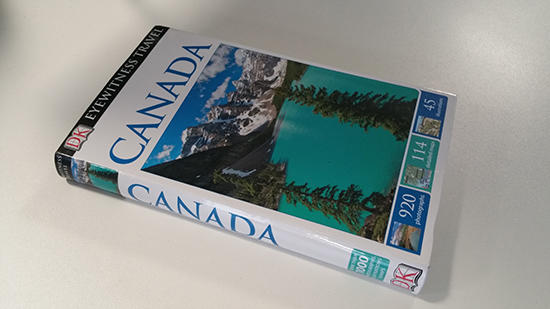
For starters the content is jargon-free, straight to the point and easy to digest, not to mention produced in a user-friendly format where it introduces the region and its highlights, before delving into the different areas in some more detail. Most importantly, it’s not too copy heavy, with a bigger focus on incredible imagery, maps and graphic illustrations for the most iconic places. Its country-wide content is pretty comprehensive too: from itinerary ideas, information on the culture, history, art, wildlife and people, and an events calendar, to a ‘Survival Guide’ at the back of the book that includes practical advice on where to stay, eat, shop and seek entertainment – information that most guidebooks assume you already know.
Title: Eyewitness Canada
Pages: 440
Weight: 650g
Verdict: Fuss-free, user-friendly and regularly revised to include up-to-date information. It could do with more unique, off-the-beaten-track content and a pull-out map though.
Best for: City breakers, first-time travellers, image lovers and those who want to tick off the well-known sights.
Lonely Planet
With a range that includes phrasebooks, region guides, city guides, tips and advice, coffee table books and even travel writing guides, I was expecting a lot from my Lonely Planet guidebook. And while initially disappointed by the lack of photography (and general weightiness of the book), I was soon won over by the level of detail packed into its many pages.

The content contains all the great nuts and bolts info, as well as tips on how to get off the beaten track, where to find the places that everyone else misses and tidbits of local info – like where to find Canada’s only tea farm. A helpful ‘Plan Your Trip’ section is invaluable too, and includes maps, top activities, a ‘need to know’ segment, recommendations based on your likes and travel dates, some French phrases, itinerary ideas and tips on travelling with children or by car. And there are some photos, plus a fantastic perforated pull-out map too, so all is not entirely lost on the visual front.
Title: Canada
Pages: 912
Weight: 715g
Verdict: More information than I knew how to handle, but that’s definitely the way I prefer it. Mainly personal preference – but a few more images would be lovely.
Best for: Adventurers who want to get off the beaten track, but also have the backpack space to spare.
Rough Guides
I’ve used Rough Guides before, though never to the extent I did for my trip to Canada. Much like Lonely Planet, it’s a bulky book with fewer pictures than I’d like but, unlike Lonely Planet, its pages are colour-coded and each section starts with an image or two. My favourite thing about Rough Guides though, is that the books generally seem to cover places that no other guide has even heard of. It ventures far off the beaten track and, as most people neglect to bring their Rough Guide on the road with them (probably due to its size!), the hidden areas often stay that way.
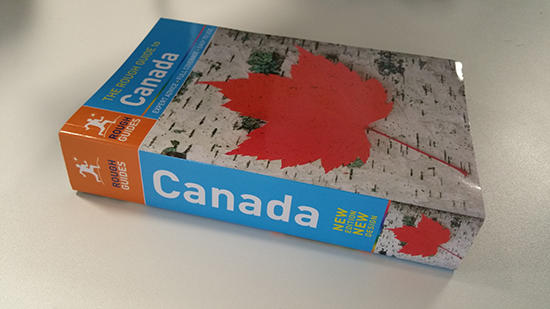
The overall content is extremely detailed, from the 50-page intro and basics sections at the front, to the detailed mapping, honest tone, budget and trip-planning information peppered throughout. It’s even got a phrase book at the back.
Title: The Rough Guide to Canada
Pages: 936
Weight: 731g
Verdict: Great all-rounder, lots of info on tourist attractions as well as more unusual sights. That said; it’s the heaviest and most cumbersome book in the test, so is better suited to pre-trip planning. The Contents section is pretty brief too.
Best for: Budget-savvy travellers looking for unique experiences.
Marco Polo
I’ll admit it: Marco Polo wasn’t really on my radar until this year – somehow I just hadn’t heard of it. And it was only when I took the guide with me to Canada that I realised I’d been missing out. For starters, it is incredibly handy and lightweight, perfect for shoving in your backpack on a hike or when you’re rafting through the Rockies. Secondly, it offers a great selection of ‘in a nutshell’ information – from insider tips to brief guides on food and drink, shopping, routes and overviews of all the main areas (NB: Northern Canada material is light, but the book only promises Western Canada, so I was surprised to see any mention of it at all!).
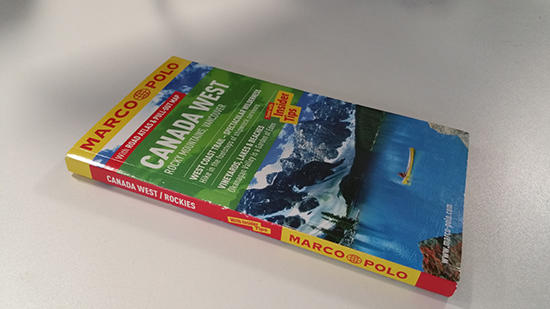
Much to my delight, all the information is backed up with an abundance of pictures and again, the different sections are colour-coded. There’s also a really helpful travel tips section, which has all the usual information (bus, train, hotels, driving, money, weather and more) plus some extra gems, like how to be sustainable on your travels.
Title: Canada West – Rocky Mountains, Vancouver
Pages: 140
Weight: 239g
Verdict: Handy, easy-to-navigate guide for when you’re on the road, boasts great maps but – most likely due to size limitations – doesn’t carry anywhere near as much information as the rest.
Best for: Travellers who are packing light, as well as those who like to get a vague idea of where to go and what to do, but then make up the rest as they go.
Bradt
This guide offered perhaps the most unfair comparison, but I tried to keep that in mind when using it alongside the others. Only one part of my journey used rail, but by far this guide was the most comprehensive on the subject, not only covering the best routes, companies and price, but also the history of rail in Canada. What it lacked in visual stimulation it more than made up for in well-researched content that covers all the key train routes in the country, how to save money and where you can get tickets from.
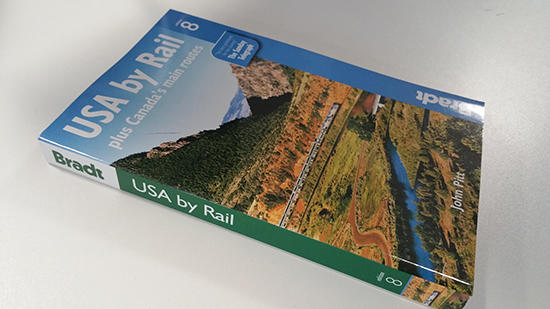
Real rail fanatics can find out about all the steam trains in Canada, as well as how and where to see them, or even ride them.
Title: USA by Rail, plus Canada’s Main Routes
Pages: 354
Weight: 425g
Verdict: The local detail in Bradt guides is phenomenally researched and well written – my main criticism for this particular trip was that I wanted to know more about Canada, but that’s more down to this specific book than the brand.
Best for: Travellers who are heading for a one region or love a certain type of travel – these guides are great for going in-depth on specific or unusual areas.




